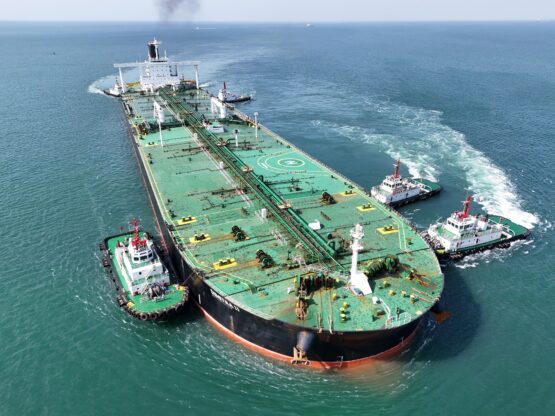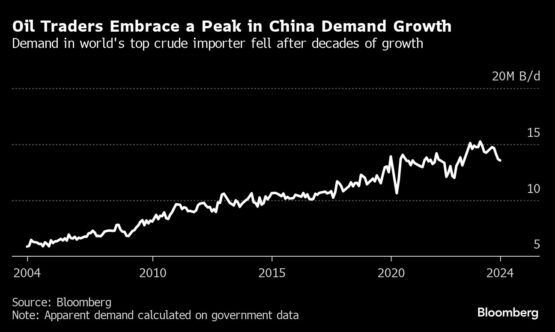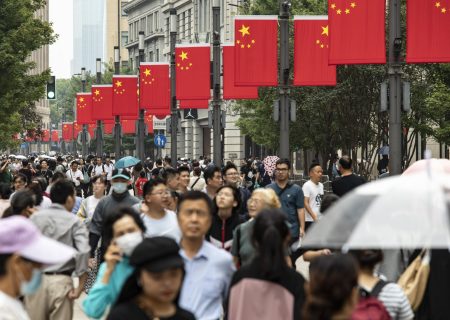For the first time in two decades, China no longer looks like the engine driving global crude demand, which is uncharted waters for many of the traders and executives that gathered for the APPEC oil conference in Singapore this week.
China’s economic situation is dire, with its property market in the doldrums and consumer confidence weak as it struggles to recover from a pandemic-induced slowdown. Add to that structural changes from an aging population, the energy transition and a growth model that leans less heavily on big-ticket infrastructure, and it’s bad news for oil.
For crude merchants and analysts, that means a big adjustment.
“I’ve had the discussion internally with my traders. I asked them one question — how long have you been trading? They’ll say 10 years,” said Janet Kong, the chief executive officer of Hengli Petrochemical International Pte, a trading arm of one of China’s largest private refiners. “My reply is, you haven’t really traded a world where China is not a bullish factor.”
China’s evolution into the world’s biggest oil importer has supported crude prices for decades and provided business opportunities for merchants from Shanghai to Dubai and London. A tolerance for low-digit GDP growth — perhaps even missing this year’s 5% target — makes that difficult to sustain.
An informal Bloomberg survey of ten analysts and traders on the sidelines of the Asia Pacific Petroleum Conference found that oil consumption in China is expected to grow by no more than 300,000 barrels a day in 2025. That’s in-line with the latest projection from International Energy Agency, which cut its expectations this week, and lower than estimates by the Organization of Petroleum Exporting Countries.
The poll showed that a 200 000 barrel-a-day expansion is expected for this year.
Respondents, who asked for anonymity as their views are not public, cited higher penetration of electric vehicles, the steady uptake of liquefied natural gas-powered trucks and government restrictions on crude imports and fuel exports. There’s also little spare storage capacity for Beijing to expand its strategic oil reserves.
Global oil demand growth is “slowing sharply” as China’s economy cools, according to a monthly report from the IEA. Chinese demand contracted in July for a fourth straight month, and fuel use elsewhere is “tepid at best.”
‘Half life’
“From a structural perspective, China now looks unlikely to be the behemoth for oil demand and perhaps even for other commodities that it once was,” Energy Aspects analysts including Amrita Sen and Livia Gallarati said in a note earlier this week, “We remain confident that the government will not allow economic growth to collapse, but growth will no doubt be lacklustre for the foreseeable future.”
Other APPEC attendees, including Hengli’s Kong, cited the changing nature of oil demand. Chemical feedstocks used to produce products such as fibres account for one-third of the nation’s total consumption — at about 5 million barrels a day — and that proportion may grow as road transport goes green. But those goods have a far longer “half-life” than fuels, Kong said, which translates to less crude being refined over time.
China’s challenging outlook clouded the annual event in Singapore, which is Asia’s largest oil conference. With Brent crude near $71 and the world’s second-largest economy showing few signs of an imminent revival, traders and refiners are bracing for lower profits.
Still, refining capacity in China continues to increase. Expansions at China Petrochemical’s Zhenhai and Cnooc’s Daxie refineries, and a brand new greenfield facility by Shandong Yulong Petrochemical Co will add a combined 740 000 barrels a day of capacity.
However, the world’s No 2 oil consumer will have to live with processing rates under 70%, traders and analysts surveyed by Bloomberg said.
Shifting sands
Not everyone is calling a peak for Chinese fossil fuel consumption — or writing off the potential for Beijing to boost growth. Trafigura Group chief economist Saad Rahim said China was still adding 8 million to 9 million new combustion engine vehicles a year.
“To me, if you’re adding new vehicles, it doesn’t feel like peak,” he said.
Others agree there is still room for growth, even in a less commodity-intensive environment.
“If the Chinese economy improves, we’ll see more discretionary driving,” said Sri Paravaikkarasu, director of market analysis at Phillips 66 International Trading. “But we should all embrace a slower demand growth from China in the coming years.”
Follow Moneyweb’s in-depth finance and business news on WhatsApp here.























COMMENTS 0
You must be signed in to comment.
SIGN IN SUBSCRIBE
or create a free account.
Free users can leave 4 comments per month.
Subscribers can leave unlimited comments via our website and app.